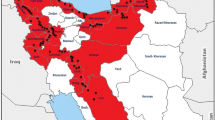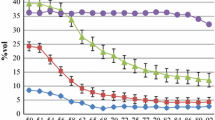Summary
The genus Paspalum contains a number of important forage grasses, including P. dilatatum Poir. (dallisgrass) and P. notatum Flugge (bahiagrass). Even though many Paspalum species are adapted to moist, humid areas, they frequently are subjected to extended periods of drought stress which reduces forage productivity. This study was initiated to determine the range of variation for different indicators of drought tolerance in several Paspalum species. Fifteen species representing a broad cross section of germplasm were grown in a replicated field nursery and sampled for leaf epicuticular wax content on four dates over three years. Wax was extracted with chloroform and quantified by the dichromate oxidation technique. Heat tolerance (solute leakage technique) was also determined by calculating the ratio of the conductivity of the external bathing solution of leaves following a heat treatment to the conductivity of the bathing solution after leaves were boiled. Wax values of the entries ranged from 5.7 to 0.88 mg/dm2. Both relative rankings and absolute wax values were very consistent across all sampling dates. The accessions of Paspalum nicorae Parodi and P. quandrifarum Lam. were consistently high in wax content, while the accessions of P. commune Lillo and P. unispicatum (Scribn. et Merr.) Nash were consistently low. The heat tolerance testing demonstrated that the accession of P. notatum var. saurae Parodi was the most heat tolerant of the entries. Results from this investigation demonstrate the wide range of diversity that exists for both epicuticular wax and heat tolerance within the genus Paspalum.
Similar content being viewed by others
References
Baker E.A. & G.M.Hunt, 1986. Erosion of waxes from leaf surfaces by simulated rain. New Phyto. 102: 161–173.
Bengston C., S.Larsson & C.Liljenberg, 1978. Effects of water stress on cuticular transpiration rate and amount and composition of epicuticular wax in seedlings of six oat varieties. Physiol. Plant. 44: 319–324.
Bouslama M. & W.T.SchapaughJr., 1984. Stress tolerance in soybeans. I. Evaluation of three screening techniques for heat and drought tolerance. Crop Sci. 24: 933–937.
Burson B.L., 1983. Phylogenetic investigations of Paspalum dilatatum and related species. Pages 170–173. In: J.A.Smith & V.W.Hays, (Eds). Proc 14'th Int. Grassland Cong, Lexington, KY Westview Press, Boulder, Colo.
Ebercon A., A.Blum & W.R.Jordan, 1977. A rapid colorimetric method for epicuticular wax content of sorghum leaves. Crop Sci. 17: 179–180.
Johnson D.A., R.A.Richards & N.C.Turner, 1983. Yield, water relations, gas exchange, and surface reflectances of near-isogenic wheat lines differing in glaucousness. Crop Sci. 23: 318–325.
Jordan W.R., P.J.Shouse, A.Blum, F.R.Miller & R.L.Monk, 1984. Environmental physiology of sorghum. II. Epicuticular wax load and cuticular transpiration. Crop Sci. 24: 1168–1173.
Jartineau J.R., J.E.Specht, J.H.Williams & C.Y.Sullivan, 1979. Temperature tolerance in soybeans. I. Evaluation of a technique for assessing cellular membrane thermostability. Crop Sci. 19: 75–78.
O'Toole J.C., R.T.Cruz & N.Seiber, 1979. Epicuticular wax and cuticular resistance in rice. Physiol. Plant. 47: 239–244.
Rao J.V.S. & K.R.Reddy, 1980. Seasonal variation in leaf epicuticular wax of some semiarid shrubs. Indian J. Exp. Biol. 18: 495–499.
Saneoka H. & S.Ogata, 1987. Relationship between water use efficiency and cuticular wax deposition in warm season forage crops grown under water deficit conditions. Soil Sci. Plant Nutr. 33: 439–448.
Sullivan C.Y., 1972. Mechanisms of heat and drought resistance in grain sorghum and methods of measurement. pp. 249–264. In: N.G.P.Rao & L.R.House (Eds). Sorghum in the seventies. Oxford & IBH Publishing Co, New Delhi, India.
Tischler C.R. & P.W.Voigt, 1990. Variability in leaf characteristics and water loss in the Weeping Lovegrass complex. Crop Sci. 30: 111–117.
Wright L.N. & A.K.Dobrenz, 1973. Efficiency of water use and associated characteristics of lehmann lovegrass. J. Range Manage. 26: 210–212.
Author information
Authors and Affiliations
Rights and permissions
About this article
Cite this article
Tischler, C., Voigt, P. & Burson, B. Evaluation of Paspalum germplasm for variation in leaf wax and heat tolerance. Euphytica 50, 73–79 (1990). https://doi.org/10.1007/BF00023163
Received:
Accepted:
Issue Date:
DOI: https://doi.org/10.1007/BF00023163




